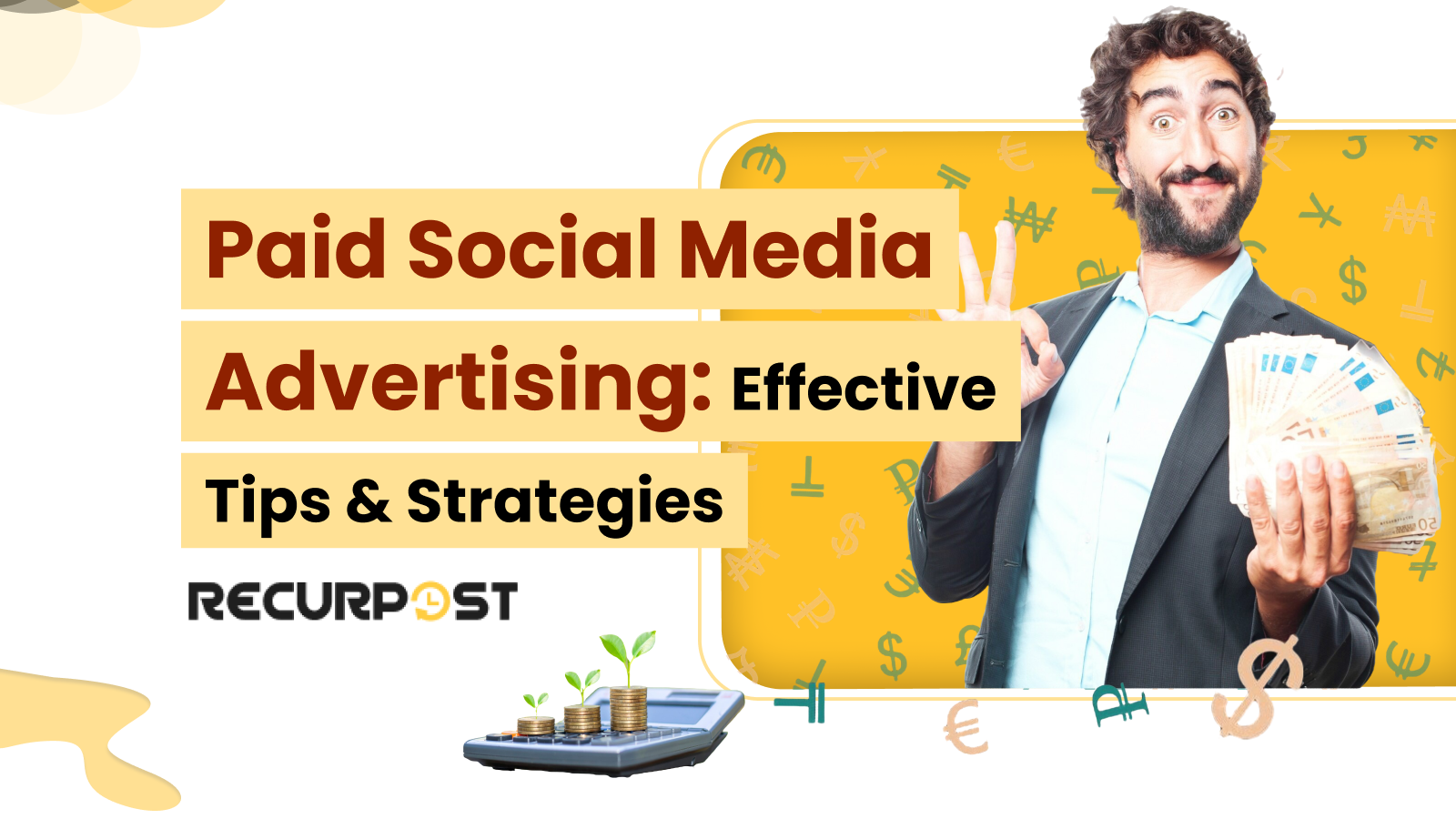If you’re a small business owner, paid social media platforms form a major part of your social media marketing strategy. Paid social media advertising on Facebook, Instagram, LinkedIn, and TikTok boosts visibility, engagement, and conversions. Success requires running social media ads smartly, not just running them. That means knowing how to craft a solid paid social media strategy services, how to set realistic budgets that maximize your ROI, and how to choose the right social media platforms for each social media marketing campaign.
This post analyzes paid social media advertising essentials that businesses and advertising companies need for effective campaigns. From paid social ads examples and tips for building a winning paid social ad campaign to breaking down the best paid social platforms, you’ll walk away with the knowledge you need to boost your client’s ad performance across the board.
Curious about how to get started? Let’s discuss what you need to know about social media ads in the current competitive landscape.
Social media ad spending is expected to grow at 10.78% annually, reaching $406.50 billion by 2029.
Differences Between Organic and Ad Posts
Knowing the key differences between organic and ad posts helps in crafting a balanced and effective social media strategy.
| Aspect | Organic Posts | Ad Posts |
| Reach | Limited to followers and their network. | Broader, includes targeted non-followers. |
| Cost | Free to publish. | Paid, requires a budget. |
| Targeting | No specific targeting; relies on algorithms. | Precise targeting (demographics, interests). |
| Objective | Builds relationships and engagement. | Focused on goals like traffic or sales. |
| Analytics | Basic metrics (likes, shares, comments). | Detailed performance tracking. |
| Longevity | Visibility fades with algorithm changes. | Visible for the paid duration. |
Paid Social Media Advertising Budgets
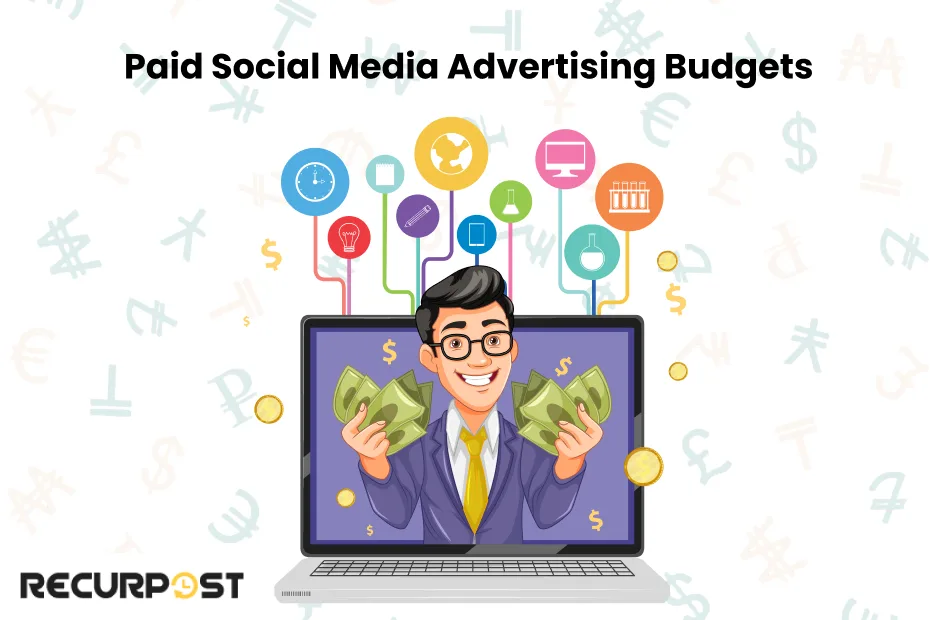
When it comes to paid social platforms, one of the first things you’ll need to determine is your ad budget. Without a solid budget, it’s easy to overspend or miss opportunities in social media marketing. So, how do you decide how much to allocate for each ad campaign and platform?
Setting a budget for paid social media campaigns follows straightforward principles. Start by understanding the cost structure on each platform. For instance, Facebook and Instagram generally operate on a cost-per-click (CPC) or cost-per-impression (CPM) model. This means you pay either every time someone clicks on your ad or every time your ad is shown.
Your budget depends on both ad costs and alignment with campaign goals. Is your goal to increase brand awareness, generate leads, or drive direct sales? The more specific your goals, the more effectively you can budget your spend for social media marketing.
Average Social Media Advertising Expenses
Knowing average ad costs for paid social campaigns is necessary for budget planning. Here’s a quick breakdown of average costs across some of the top platforms:
| Platform | Average CPC | Average CPM |
| $0.97 | $7.19 | |
| $1.20 | $7.91 | |
| $5.26 | $6.59 | |
| $0.50 – $2.00 | $6.46 | |
| TikTok | $1.00 – $3.00 | $10.00 – $12.00 |
These rates represent average paid social media advertising costs but can vary based on factors like your industry, audience targeting, and campaign type.
Analyzing your specific industry and target audience provides detailed information on advertising costs, enabling better budget estimation and optimization.
How Much Does Social Media Marketing Cost for Small Business
How Much Should You Spend on Social Ads?
Budget requirements vary by campaign size: smaller campaigns start with a few hundred dollars, while larger campaigns require thousands of dollars plus digital marketing tools. However, there are a few guidelines that can help for your social media marketing:
- Start with testing: Allocate a smaller portion of your budget initially to test different ad creatives, targeting options, and social media platforms. A/B testing is a great way to optimize your budget over time.
- Track your ROI: Don’t just run paid ads and forget about them. Track the performance of each ad using metrics like cost-per-click (CPC), cost-per-lead (CPL), and return on ad spend (ROAS). This will help you figure out where to increase or decrease your spend for the best results.
Continuous experimentation and adjustment establish balance between campaign goals and budget constraints.
Budgeting for Paid Social by Business Type
| Business Type | Monthly Budget | Strategy |
|---|---|---|
| Small Biz | $300–$1,000 | Focus on retargeting + one platform |
| Mid-size | $1,000–$5,000 | Run 2–3 platform tests, A/B creatives |
| Enterprise | $10,000+ | Omnichannel ads with automation + reporting dashboards |

Start with 70% on best-performing platform, 30% on tests. Adjust seasonally (e.g., Q4 boosts for eCommerce)
Benchmarks to Keep in Mind for Paid Social Platforms
To give you a clearer idea of what to expect, here are some general benchmarks for common paid social platforms for social media marketing:
| Platform | CPC Range | CPM Rang | Notes |
| Facebook Ads | $0.50 – $3.00 | $5 – $15 | Costs vary based on industry and targeting. |
| Instagram Ads | $0.50 – $3.00 | $5 – $15 | Pricing is similar to Facebook, but can be higher for younger audiences. |
| LinkedIn Ads | $2.00 – $7.00 | N/A | Ideal for B2B marketing; more expensive |
| TikTok Ads | $1.00 – $3.00 | $10.00 | Prices vary greatly; higher CPM than other platforms. |
How to Track and Report Paid Social Ad Spend
- Use platforms like Meta Ads Manager, LinkedIn Campaign Manager, or TikTok Business Center
- Track metrics like: total spend, CPC, CTR, ROAS, CPA
- Segment reports by platform, campaign, and date
- Use Google Data Studio or HubSpot to build custom dashboards
- Actionable reports help you: reallocate budgets, pause underperforming ads, and optimize campaigns
Effective Paid Social Media Advertising Strategies
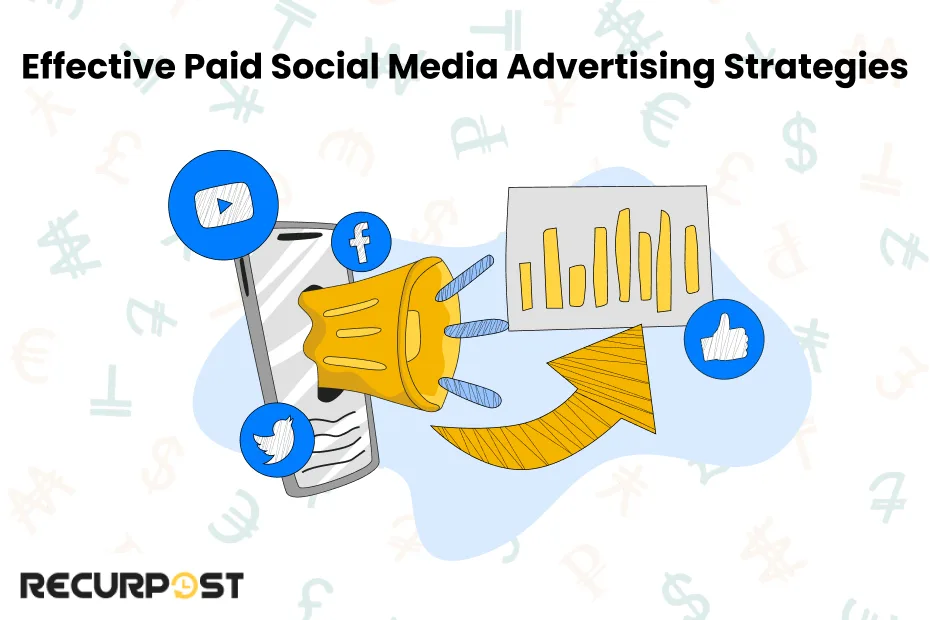
When it comes to running social media campaign, a solid strategy is essential. Even if you have the best ad creatives or the perfect budget, your campaign won’t be successful without a well-thought-out approach. So, what makes a paid social media strategy truly effective?
Here are some key strategies you can use to ensure your campaigns deliver:
1. Targeting the Right Audience
Social media platforms provide detailed audience targeting options, allowing precise definition of ideal audiences based on demographics, behaviors, and job titles. You can target based on demographics (age, location, interests), behaviors (purchasing habits, online activity), and even job titles (especially on LinkedIn).
2. Use A/B Testing to Find What Works
Testing all elements is key to maximizing your ad budget: your ad creatives, headlines, call-to-actions, and audiences.This is where A/B testing comes into play. By running multiple variations of your paid ads, you can determine which elements perform the best.
For instance, test:
- Different images or videos to see what resonates most with your audience.
- Various calls to action (CTA). Does “Shop Now” outperform “Learn More”?
- Different ad formats—carousel ads vs. single-image ads, or story ads vs. feed ads.
Extensive testing reveals effective elements, optimizing paid social media strategy over time.
3. Leverage Retargeting Ads
Retargeting shows ads to people who previously interacted with your brand through website visits or social media engagement, significantly boosting conversions.
Retargeting keeps your brand top-of-mind and brings people back to complete the action, whether it’s signing up for a newsletter, purchasing a product, or downloading a guide. On social media platforms like Facebook and Instagram, you can create a custom audience of people who’ve already visited your site or viewed specific pages. This allows you to target them with tailored ads.
4. Test Different Platforms for Different Goals
Each social media platform serves different campaign goals based on its unique strengths and audience characteristics. For example:
- Facebook and Instagram are perfect for brand awareness and lead generation, thanks to their massive user base and advanced targeting options.
- LinkedIn is your go-to for B2B campaigns, especially if you’re aiming for lead generation from professionals.
- TikTok and YouTube work best for brand engagement and creating viral content. If you’re looking to boost product discovery through short, engaging videos, these social media platforms are key.
By aligning your platform with your campaign’s goal, you’ll spend your ad budget in a more strategic way and get the most out of your efforts.
5. Creative that Speaks to the Target Audience
Attention-grabbing visuals through high-quality images, short-form videos, or well-designed carousels differentiate successful ads. But it’s not just about looking good—your ad creative needs to speak to your target audience.
Ensure your messaging addresses your target audience’s pain points and needs. Use language they relate to, and don’t be afraid to add value right away. If you’re targeting a specific audience, such as professionals or fitness enthusiasts, make sure your visuals and messaging are tailored to that group.
6. Advanced Paid Social Optimization Techniques
(i) Creative Rotation: Change creatives every 10–14 days to avoid fatigue
(ii) Audience Layering: Stack lookalikes + behavioral segments
(iii) Bid Strategy Tuning: Try manual bidding for high-intent campaigns
(iv) Cross-Platform Learnings: Use top-performing copy from Facebook in LinkedIn or YouTube
(v) Landing Page Testing: Match ad copy with landing content for better Quality Score
How to Build a Paid Social Media Advertising Strategy
Step 1: Define Objectives: Set clear goals (e.g., awareness, leads, sales) and choose KPIs.
Step 2: Know Your Audience: Use buyer personas and interest/behavior filters.
Step 3: Pick the Right Platform: Match platforms to your goals (LinkedIn for B2B, Instagram for Gen Z, etc.).
Step 4: Craft Creatives: Design visuals that match your platform and audience.
Step 5: Set Budgets and Bids: Allocate by campaign priority and ad type.
Step 6: Track & Analyze: Install pixels, enable UTM parameters, and track conversions.
Step 7: Optimize: Use data to improve targeting, creative, and bids continuously.
Top Paid Social Media Advertising Platforms
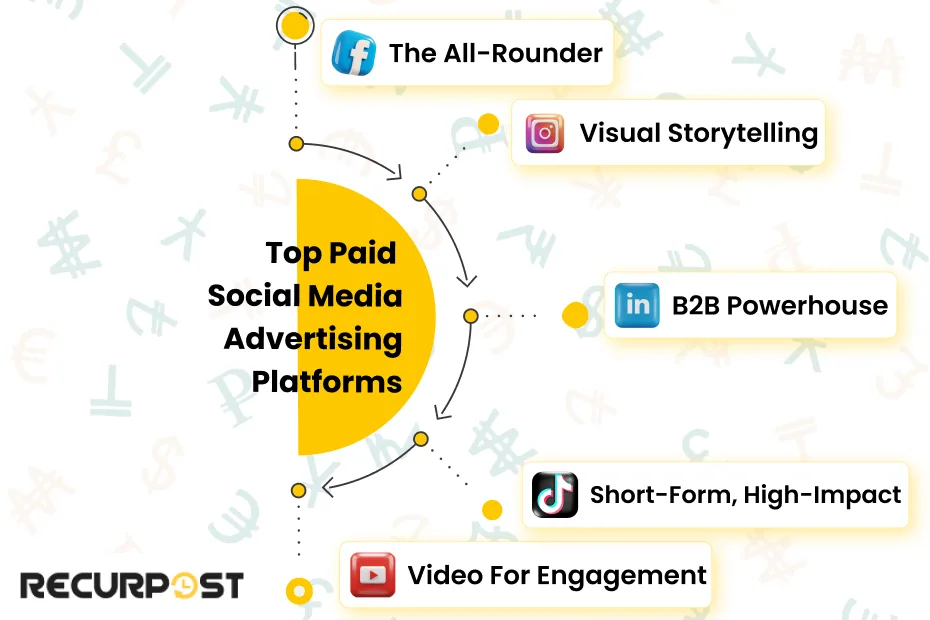
Choosing which platforms to prioritize for your ad spend can be challenging. Each platform has its own strengths, and choosing the right one for your campaign is crucial. Here’s a breakdown of the top paid social platforms and what they’re best for:
1. Facebook Ads: The All-Rounder
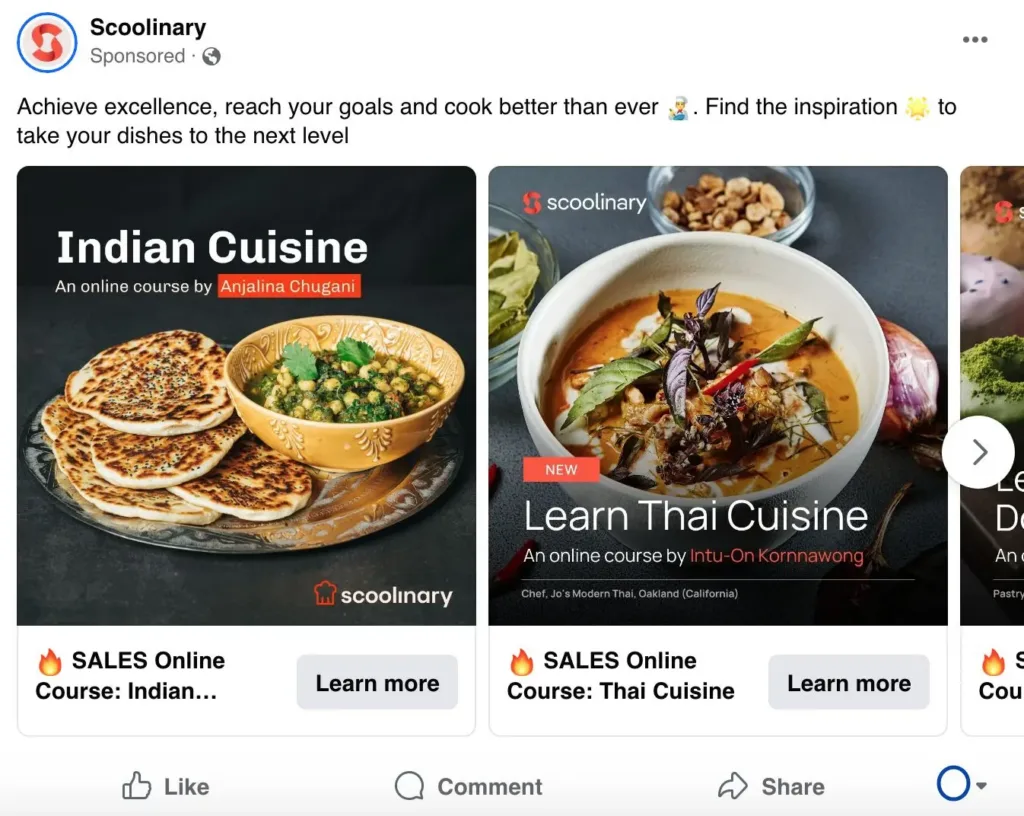
Source: Semrush
Facebook remains one of the most effective paid social platforms, especially for businesses looking to target a broad audience. With over 2.9 billion active users, Facebook allows you to target users by location, interests, demographics, behaviors, and more.
What’s great about Facebook Ads?
- It offers a variety of ad types, from carousel ads to video ads.
- You can leverage Facebook’s powerful algorithm to optimize ad delivery and targeting.
- Facebook Pixel helps you track conversions and retarget visitors, boosting your campaign’s ROI.
Best for: Brand awareness, lead generation, and e-commerce campaigns. Facebook is also perfect if you’re looking to run retargeting campaigns based on website visitors or engagement.
2. Instagram Ads: Visual Storytelling
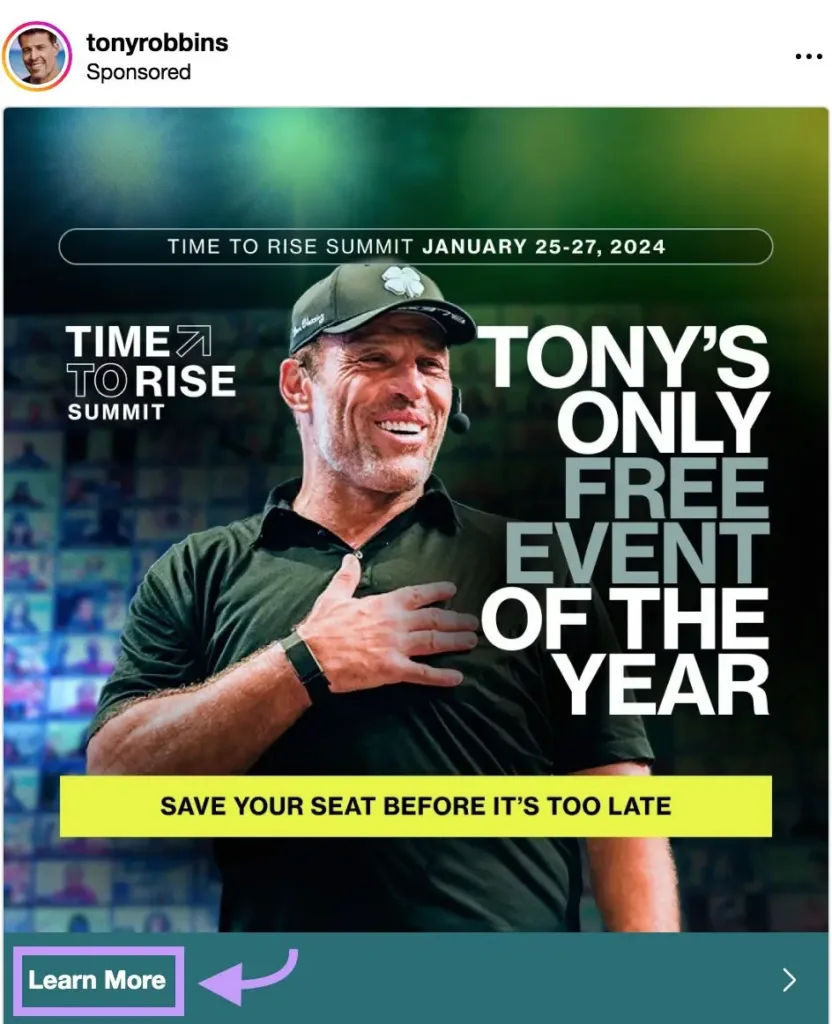
Source: Semrush
If your target audience skews younger (Gen Z or Millennials), Instagram is a must. It’s highly visual, making it perfect for businesses that sell products, services, or experiences that can be showcased through images or video ads.
Instagram ads are integrated into the feed and Stories, so they feel native to the platform. Plus, features like Instagram Shopping allow businesses to sell directly through the app, creating an easy path for conversion.
What’s great about Instagram Ads?
- Instagram offers engagement-driven features, such as Stories, Reels, and influencer partnerships, which can drive awareness and engagement.
- Instagram’s targeting options are just as robust as Facebook’s, thanks to their integration with Facebook’s ad platform.
- The visual-first format allows brands to showcase their products in creative ways.
Best for: Brand awareness, product discovery, and driving sales—especially in industries like fashion, beauty, and food.
3. LinkedIn Ads: B2B Powerhouse
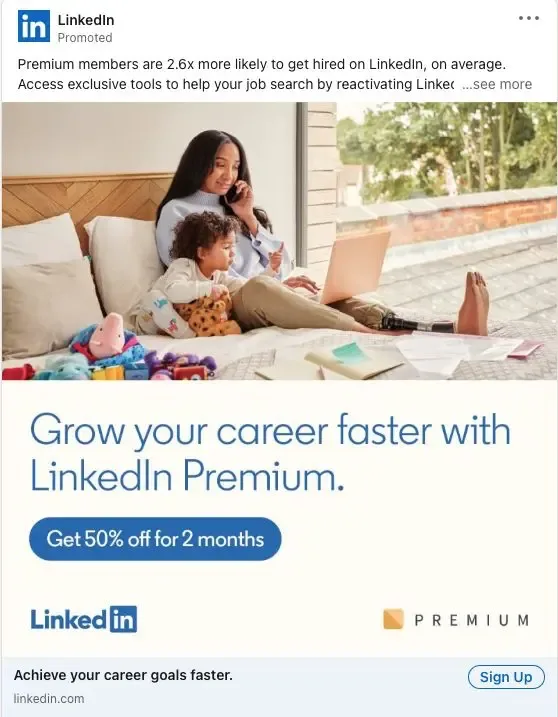
Source: Semrush
When it comes to reaching professionals, LinkedIn is the undisputed king. With over 700 million professionals, LinkedIn is a top platform for B2B advertising and targeting decision-makers within companies.
LinkedIn’s ad types include sponsored content, message ads, and dynamic ads. These formats allow you to target users based on job title, company, industry, and more.
What’s great about LinkedIn Ads?
- LinkedIn has high-quality audience targeting options, which make it easier to reach key decision-makers and professionals in any industry.
- It’s an excellent platform for lead generation—you can even use Lead Gen Forms to capture information without requiring users to leave the platform.
Best for: B2B lead generation, recruitment ads, and thought leadership campaigns.
4. TikTok Ads: Short-Form, High-Impact
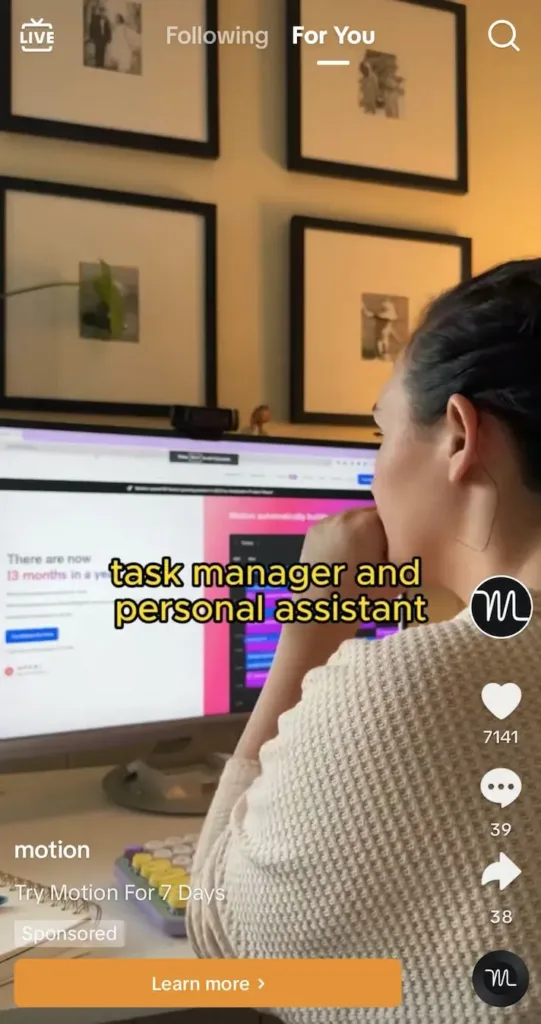
Source: Semrush
TikTok is rapidly becoming one of the most popular platforms for paid social media advertising, especially if you’re targeting a younger audience (mostly Gen Z). TikTok is known for its viral, creative content, making it a great platform for brands looking to engage and entertain.
TikTok offers in-feed ads, branded hashtag examples, and branded effects, allowing brands to create engaging and interactive social media marketing campaigns.
What’s great about TikTok Ads?
- TikTok’s engagement rates are through the roof, especially for videos that feel authentic and not overly polished.
- Brands can create viral challenges, encouraging users to create content with your product or service.
- The in-feed ads feel native to the platform, making them less intrusive and more likely to grab attention.
Best for: Brand awareness, product discovery, and viral marketing campaigns.
5. YouTube Ads: Video for Engagement
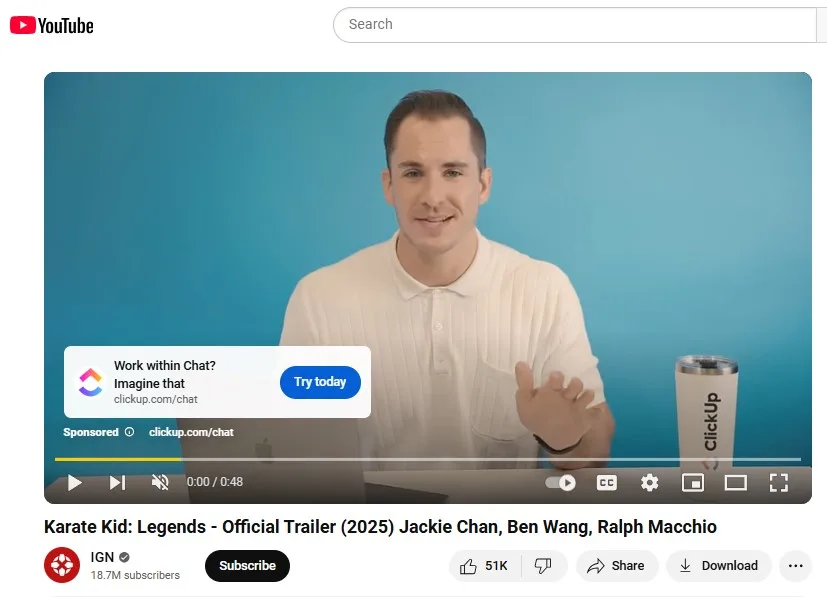
YouTube remains the dominant platform for video content, with over 2 billion monthly active users. It’s ideal for brands looking to run video ads to engage users in a more immersive format.
With YouTube, you can run skippable ads, non-skippable ads, display ads, and bumper ads, depending on your campaign objectives.
What’s great about YouTube Ads?
- Video ads provide a great opportunity to engage users with compelling storytelling.
- You can use TrueView ads, where advertisers only pay when users watch at least 30 seconds of the ad.
- YouTube’s targeting is highly granular, allowing you to target based on interests, demographics, search history, and even YouTube behavior.
Best for: Brand awareness, product demos, and driving website traffic.
Don’t Miss: Learn More About Best Social Media Marketing Apps for 2025
Paid Social Media Advertising Examples
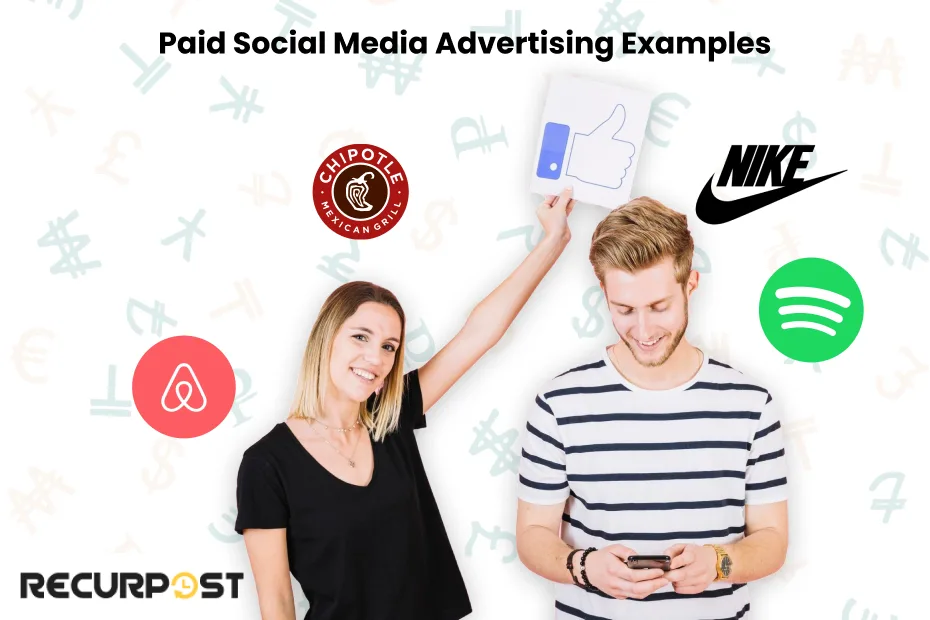
These successful paid social media campaign examples demonstrate effective strategies:
- Airbnb (Facebook Ads): Airbnb uses highly targeted Facebook ads with stunning visuals to appeal to travelers interested in unique stays. They leverage Facebook’s powerful targeting tools to focus on specific interests, ensuring ads reach the right people.
- Nike (Instagram Reels): Nike partners with influencers on Instagram Reels, creating engaging, short-form content that showcases their products in action. This approach drives brand awareness and product sales, especially with seamless shopping features.
- Chipotle (TikTok #GuacDance): Chipotle’s TikTok challenge invited users to dance for free guacamole, creating viral engagement. This fun campaign effectively tapped into TikTok’s youthful audience.
- Spotify (Personalized Ads): Spotify uses personalized ads based on listening habits, showing users relevant concert ads or music promotions. The targeted, data-driven approach makes ads feel more like suggestions, increasing user engagement.
- Canva (LinkedIn Ads): Canva runs carousel ads on LinkedIn showcasing how teams can collaborate visually. The campaign targets design professionals and marketers by job title, helping Canva position itself as a B2B productivity tool.
- Glossier (Instagram Shopping Ads): Glossier uses Instagram Shopping Ads with high-quality visuals that link directly to product pages. These ads are tailored to beauty enthusiasts and leverage Instagram’s native shopping flow to drive impulse purchases.
- Monday.com (YouTube Pre-Roll Ads): Monday.com runs YouTube ads with fast-paced demos of its project management tools. These skippable ads are aimed at business users and emphasize pain points like disorganization and slow workflows.
- Gymshark (Facebook Retargeting Ads): Gymshark uses Facebook retargeting to show dynamic product ads to users who viewed items but didn’t purchase. By offering limited-time discounts and showing customer reviews, they successfully re-engage potential buyers.
Paid Social Media Ads Best Practices: Do’s and Don’ts
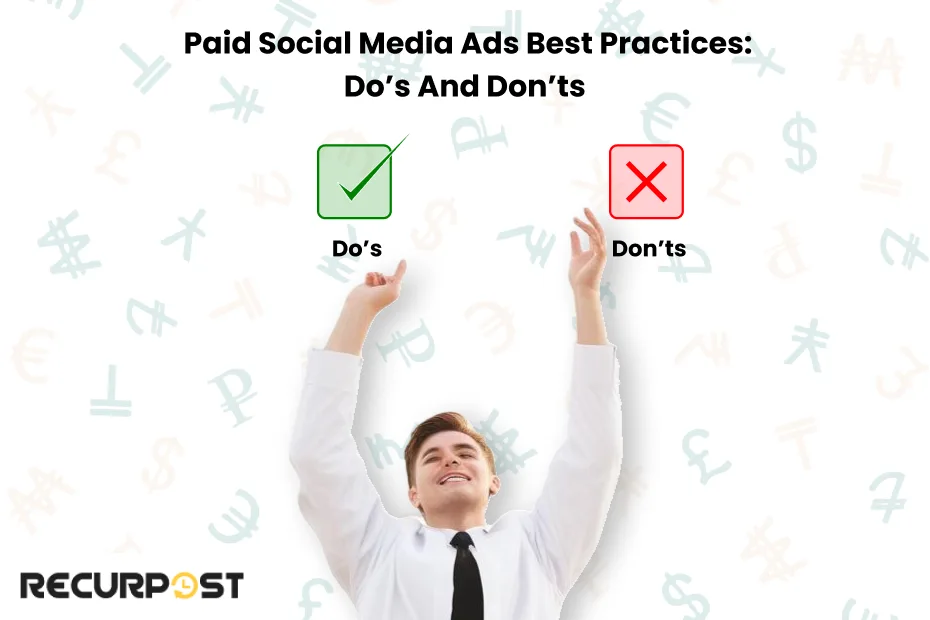
Following the right practices is essential for effective paid social media campaigns. Below are the do’s and don’ts to help you run more effective campaigns.
Do’s for Successful Paid Social Media Ads:
| Best Practice | Why It Works | Tip |
| Use High-Quality Visuals | High-quality visuals capture attention and increase engagement. | Always use high-resolution images. Ensure they are sized properly for each platform and reflect your brand’s style and message |
| Test Multiple Variations | A/B testing helps you find what works best with your target audience. | Test one variable at a time (e.g., test two headlines or two images). Keep other elements constant for accurate results. |
| Focus on a Single, Clear CTA | A single, concise CTA helps guide the audience toward the desired action. | Keep your CTA simple and direct, such as “Shop Now” or “Learn More.” |
| Use Detailed Audience Targeting | Highly targeted ads resonate more with the right target audience, boosting engagement and conversions. | Use demographic, interest, and behavioral targeting. Consider retargeting people who have interacted with your brand. |
| Monitor Analytics Regularly | Analytics provide valuable insights into what’s working and what’s not. | Track key performance indicators (KPIs) like CTR, conversion rates, and ROAS to optimize your campaigns. |
Don’ts for Avoiding Pitfalls in Paid Social Media Ads:
| Mistake | Why It’s a Mistake | Tip |
| Overloading Ads with Text | Too much text can make your ad cluttered and difficult to read, reducing engagement. | Limit text to 20% of the image area. Keep the text minimal and let the visuals communicate the message. |
| Ignoring Mobile Optimization | A large portion of social media activity is mobile, so unoptimized ads can have a high bounce rate. | Test your ads on mobile devices before launch. Ensure your text is legible and your visuals are cropped correctly for smaller screens. |
| Running the Same Ads for Too Long | Repetitive ads can lead to ad fatigue, reducing engagement and performance. | Refresh your creatives regularly and rotate ads to keep the audience engaged. |
| Relying Only on One Platform | Focusing on just one platform can limit your audience reach. | Spread your paid social strategy across platforms like Facebook, Instagram, LinkedIn, and TikTok to reach a broader audience. |
| Ignoring Platform-Specific Guidelines | Every platform has unique ad specs and guidelines. Ignoring them can lead to poor performance or ad disapproval. | Familiarize yourself with the ad guidelines of each platform to ensure your ads are optimized for them. |
Conclusion
Successful paid social media campaigns combine strategic planning, testing, appropriate tools, and continuous optimization. Success requires eye-catching ads, precise audience targeting, efficient budget management, and data-driven refinement.
Success in paid social media management depends on recognizing each platform’s unique characteristics, tailoring your ads to match the platform’s format, and staying agile enough to adjust strategies as needed. By applying the best practices and avoiding common pitfalls, your business can maximize ROI and deliver more impactful results for your clients.
The space of paid social media advertising can be complex, but with a clear strategy and the right tools, your business is well on its way to achieving digital marketing success.
FAQ
1. What is the difference between CPC and CPM?
CPC (Cost Per Click): You pay each time someone clicks on your ad. This is typically used when the goal is to drive traffic or conversions.
CPM (Cost Per Thousand Impressions): You pay based on how many times your ad is shown, regardless of whether it’s clicked. This is usually used for brand awareness campaigns.
2. How can I optimize my ad targeting for better results?
Targeting can make or break your ad campaign. Here’s how to optimize:
1) Use audience segmentation to reach the right people based on demographics, interests, behaviors, or job titles.
2) Leverage lookalike audiences to reach people similar to your current customers.
3) Refine your targeting over time based on campaign performance—testing different segments will give you insights into which audience performs best.
3. What’s the best platform for paid social ads in 2025?
The best platform depends on your target audience:
Facebook & Instagram are great for consumer-focused brands, especially those targeting broad demographics or specific interests.
LinkedIn excels for B2B marketing, especially if you’re targeting professionals or specific industries.
TikTok is ideal for reaching younger, highly engaged audiences with creative, video-driven content.
4. How much should I allocate for my first paid social campaign?
Start small and test. A budget of $300 to $500 is a good starting point for most businesses. This allows you to experiment with creatives, targeting, and platforms. Once you find what works, you can gradually increase your budget for better reach and results.
5. How can I reduce the cost of my paid social ads?
To lower costs, consider:
Improving your Quality Score: Platforms like Facebook and Google reward ads with higher engagement by reducing costs.
A/B testing: Continuously test different ad creatives, copy, and targeting to identify what works best.
Optimizing your bidding strategy: Adjust bidding strategies based on the type of campaign (e.g., switching from CPM to CPC if you’re aiming for clicks).
6. How do I know if my ad campaign is successful?
Measure your success using KPIs (Key Performance Indicators) that align with your goals:
Trffic: Focus on CPC and Click-Through Rate (CTR).
Leads: Track Cost Per Lead (CPL).
Sales: Monitor ROAS (Return on Ad Spend) and conversion rates.
7. What are the risks of spending too much on social ads?
Overspending without tracking results can lead to wasted budget and poor ROI. It’s important to set clear goals, track performance, and optimize campaigns regularly to avoid this risk. A structured A/B testing approach can also help ensure you’re spending wisely.
8. Can I run social media ads with a small budget?
Yes, you can! Platforms like Facebook, Instagram, and Twitter offer flexible budgeting options. Start small and focus on testing different creatives and targeting options. You can scale as you learn what works best for your audience.
9. What should I consider when choosing between CPC and CPM?
Use CPC when your goal is direct response—getting people to click on your ad and convert.
Use CPM for brand awareness campaigns where the focus is on getting impressions rather than immediate clicks.
10. How do I optimize my ad creatives for better performance?
Use high-quality visuals: Clear and engaging images or videos always perform better.
Craft compelling copy: Ensure your ad copy is concise, speaks to the pain points of your audience, and has a clear call-to-action (CTA).
Test different types of social media advertising: Carousel ads, video ads, and single image ads may perform differently depending on the platform and audience.

Ruchi Dhimar is a skilled content writer with 4 years of experience. She is passionate about crafting compelling narratives, specializing in writing content for different industries.
